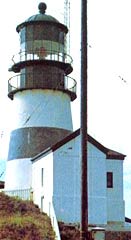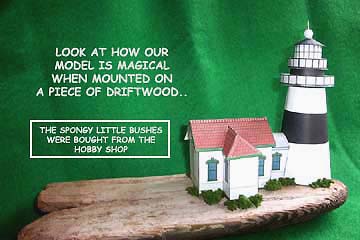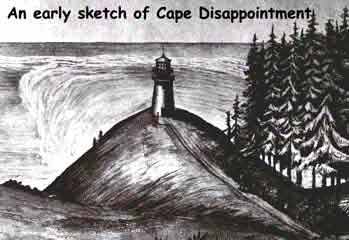

Cape Disappointment - $$4.95
The Cape Disappointment Lighthouse is the oldest in Washington. Still operating, it has guided ships along the coast and across the Columbia River bar since 1856. Cape Disappointment State Park (formerly Fort Canby State Park) is a 1,882-acre camping park on the Long Beach Peninsula, fronted by the Pacific Ocean. The park offers two miles of ocean beach, two lighthouses, an interpretive center and hiking trails.
The Cape Disappointment Light House, Ilwaco, WA

The idea of building a lighthouse on Cape Disappointment was first mentioned in the 1848 act creating Oregon Territory, which included present-day Washington. The act made provision for "the construction of lighthouses at Cape Disappointment and New Dunginess [sic]. . . . " At the time there were no lighthouses on the West Coast, and Cape Disappointment was a logical place for one.
The cape, a headland on the north side of the Columbia River's mouth, was named by British fur trader John Meares. In 1788 he was looking for a great river described by a Spanish sea explorer. Unable to find the river, Meares named the headland Cape Disappointment.
Four years later, Boston fur trader Captain Robert Gray found the river and named it for his ship, Columbia Rediviva. Despite its treacherous bar, the Columbia River soon became an important waterway for Americans and British engaged in the fur trade.
The first known beacon on Cape Disappointment in 1812 assisted the American ship Beaver, which was bringing supplies to Fort Astor, now Astoria. Oregon. For several days the ship lay off the Columbia's entrance. waiting for favorable conditions at the bar. To assist the ship, men from the fort rowed twelve miles across the river and climbed to the top of the headland. They hoisted a white flag and at night set fire to trees, "to serve in lieu of a lighthouse," wrote one.
CAPE DISAPPOINTMENT LIGHT
Ilwaco (1856)
This cape received its melancholy name from the trader John Meares, Who mistook the headland for another landfall farther south-the one now named for him-and sailed away in disappointment. The captains of many other ships have encountered another, more bitter form of disappointment at this cape. Countless vessels have foundered here and on the nearby Columbia River bar.
Federal surveyors recommended as early as 1848 that a lighthouse be erected on the cape, but eight years went by before one was finally completed. Constructing a station on the isolated cape proved far more difficult and expensive than anyone had imagined. During the fall of 18S3, the bark Oriole foundered on the Columbia River bar while attempting to deliver materials for the tower. It took almost a year to bring in a second shipment. Once it arrived downpours and deep mud further delayed the project. Finally, in 1856, the fifty-three-foot conical tower was finished, and the oil lamps inside its first order Fresnel lens were lit on October 15 of that year.
In 1898 the Cape Disappointment Lighthouse lost its classic first-order lens and much of its status to the recently completed light station on nearby North Head. A fourth-order Fresnel optic replaced the original lens and remains in operation. It displays alternating red and white flashes.
For many years the station's closest neighbor was Fort Canby. Bristling with artillery, the fort controlled access to the Columbia. The concussion of its huge guns sometimes shattered windows in the tower.
Travel information: From Ilwaco, follow signs for Cape Disappointment and Fort Canby State Park. Visitors can reach the lighthouse via a short hike from a well-marked parking area. The park's Lewis and Clark Interpretive Center offers exhibits that celebrate the famous explorers and their visit to the cape nearly two centuries ago. Call (360) 642-3078.
 The
mighty Columbia River, born in the Canadian Rockies, is a powerhouse
of hydroelectric energy long before it is joined by the Snake
River to sweep westward and form the boundary between Oregon and
Washington. By the time the Columbia passes through the Cascade
Mountains and several more power dams to empty into the Pacific
Ocean near Astoria, the river merges unwillingly into the sea
in a raging cauldron of frothing white water. Bubbling and seething
over shifting shoals of sand with surging bar swells, it threatens
to devour any ship caught in its mouth in 1853, lighthouse builders
from the grueling construction project at Farallon Islands were
sent to build a station at Cape Disappointment on the north side
of the river mouth. Their ship Oriole, bringing building materials
and workers to the new job, was wrecked on the river bar in plain
view of the proposed watchtower site. The crew and passengers
were saved in a harrowing rescue but the vessel and cargo were
lost.
The
mighty Columbia River, born in the Canadian Rockies, is a powerhouse
of hydroelectric energy long before it is joined by the Snake
River to sweep westward and form the boundary between Oregon and
Washington. By the time the Columbia passes through the Cascade
Mountains and several more power dams to empty into the Pacific
Ocean near Astoria, the river merges unwillingly into the sea
in a raging cauldron of frothing white water. Bubbling and seething
over shifting shoals of sand with surging bar swells, it threatens
to devour any ship caught in its mouth in 1853, lighthouse builders
from the grueling construction project at Farallon Islands were
sent to build a station at Cape Disappointment on the north side
of the river mouth. Their ship Oriole, bringing building materials
and workers to the new job, was wrecked on the river bar in plain
view of the proposed watchtower site. The crew and passengers
were saved in a harrowing rescue but the vessel and cargo were
lost.
Continuing construction difficulties plagued the project but at last, a 53-foot-conical masonry tower and keeper's dwelling was completed in 1854. History repeated itself when it was discovered that the tower had to be enlarged to accommodate the 1st-order lantern and lens. Two more years passed before the light went into service in 1856. The lighthouse served for forty-two years when a new coastal tower was built at North Head and the 1st-order Fresnel lens was moved to the new station. A 4th-order lens was installed in Cape Disappointment's old lantern and it became a harbor light that is still active today.
Cape Disappointment , Washington's senior sentinel, is one of just three survivors among the first eight lighthouses constructed on the West Coast. Established in 1856 at the mouth of the Columbia River, it remains today as a stately reminder of the area's pioneering days.Late in the summer of 1853, construction gangs employed at building the remote Southeast Farallon (CA) Lighthouse loaded building materials aboard the bark Oriole and sailed north to begin work at Cape Disappointment. Entering the mouth of the Columbia River, their vessel struck a shoal, rolled over, and sank. Everyone aboard survived, but the gear and supplies were all lost. Nearly a year passed before replacement materials arrived. When they did, work began in earnest, and crews erected a stout masonry tower, 53 feet high, with tapering walls five feet thick at the base and three feet at the top. Cape Disappointment Light began operating 15 October 1856, casting a white light from 220 feet above the river's entrance.
Although the new light was a welcome beacon to mariners entering the Columbia River, many claimed it was impossible to discern its rays from the north. As a remedy, the Lighthouse Board in 1898 built a second lighthouse-North Head Light-on the north side of the promontory and moved Cape "Us" lens to the new tower. Cape Disappointment received a fourth-order optic, programmed to show alternating red and white flashes.
Cape Disappointment Light was automated in 1962. During the early 1980s, Coast Guard crews completed extensive renovations to the tower, inside and out, and added the broad black horizontal band midway up the exterior, to better distinguish it from its North Head neighbor.
 |
 |
 |


